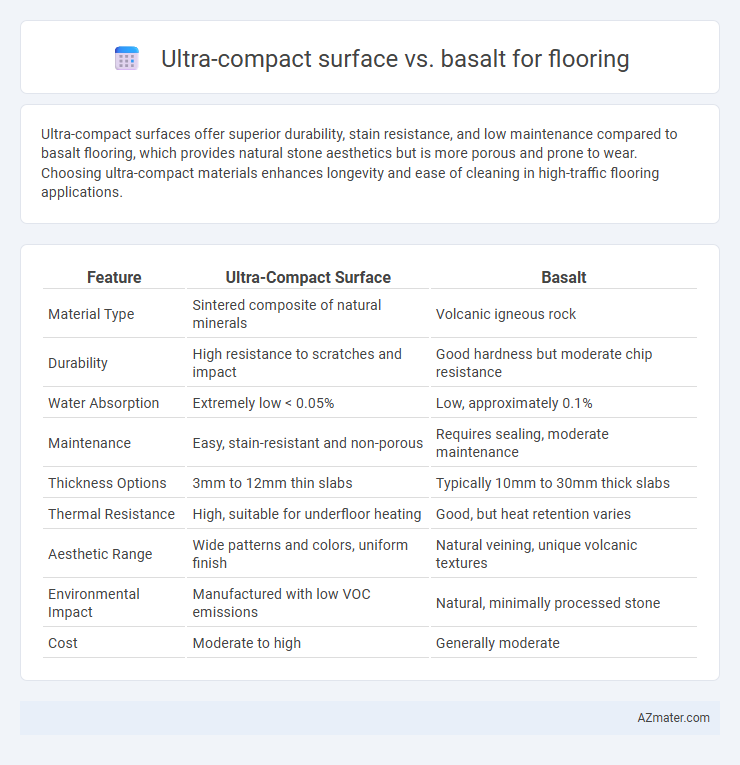Ultra-compact surfaces offer superior durability, stain resistance, and low maintenance compared to basalt flooring, which provides natural stone aesthetics but is more porous and prone to wear. Choosing ultra-compact materials enhances longevity and ease of cleaning in high-traffic flooring applications.
Table of Comparison
| Feature | Ultra-Compact Surface | Basalt |
|---|---|---|
| Material Type | Sintered composite of natural minerals | Volcanic igneous rock |
| Durability | High resistance to scratches and impact | Good hardness but moderate chip resistance |
| Water Absorption | Extremely low < 0.05% | Low, approximately 0.1% |
| Maintenance | Easy, stain-resistant and non-porous | Requires sealing, moderate maintenance |
| Thickness Options | 3mm to 12mm thin slabs | Typically 10mm to 30mm thick slabs |
| Thermal Resistance | High, suitable for underfloor heating | Good, but heat retention varies |
| Aesthetic Range | Wide patterns and colors, uniform finish | Natural veining, unique volcanic textures |
| Environmental Impact | Manufactured with low VOC emissions | Natural, minimally processed stone |
| Cost | Moderate to high | Generally moderate |
Introduction to Ultra-Compact Surface and Basalt Flooring
Ultra-compact surfaces are engineered materials composed of finely ground natural minerals and resins, renowned for their exceptional durability, resistance to scratches, stains, and heat. Basalt flooring, derived from volcanic rock, offers natural strength, thermal stability, and a unique textured appearance, making it a popular choice for both indoor and outdoor applications. Both materials provide sustainable, low-maintenance flooring solutions with distinct aesthetic and performance characteristics suited to high-traffic environments.
Composition and Material Properties
Ultra-compact surfaces consist of finely milled quartz, porcelain, and glass particles fused under high pressure and temperature, resulting in exceptional density and low porosity compared to natural basalt. Basalt, a volcanic igneous rock, is naturally dense and durable but more porous than engineered ultra-compact materials, affecting stain resistance and maintenance. The engineered composite structure of ultra-compact surfaces offers superior hardness, scratch resistance, and chemical stability compared to basalt's natural mineral composition.
Aesthetic Variations: Colors and Textures
Ultra-compact surfaces offer a wide range of aesthetic variations, including vibrant colors and intricate textures that mimic natural stone, wood, or concrete, providing flexibility for modern interior designs. Basalt flooring, known for its deep, rich dark tones and naturally rough textures, delivers a more uniform and earthy appearance ideal for creating a sophisticated yet rustic ambiance. The diverse color palette and textural options of ultra-compact surfaces surpass basalt's traditional look, making them a preferred choice for customizable and contemporary flooring solutions.
Durability and Resistance to Wear
Ultra-compact surfaces exhibit exceptional durability and high resistance to wear, making them ideal for heavy-traffic areas due to their dense composition and low porosity. Basalt flooring offers natural hardness and abrasion resistance but tends to be more susceptible to chipping and surface scratches over time compared to ultra-compact materials. The superior toughness and maintenance ease of ultra-compact surfaces make them preferable for environments demanding long-lasting, wear-resistant flooring solutions.
Installation Process and Techniques
Ultra-compact surfaces offer a streamlined installation process due to their thin, lightweight slabs that require minimal subfloor preparation and allow for quicker setting times compared to traditional basalt stone flooring. Basalt flooring installation demands precise cutting and heavy-duty handling, often necessitating professional expertise and specialized tools to manage its dense, hard texture. The ease of installation with ultra-compact surfaces reduces labor costs and downtime, making them a preferred choice for modern commercial and residential applications.
Maintenance and Cleaning Requirements
Ultra-compact surfaces require minimal maintenance, resisting stains, scratches, and chemicals, making them ideal for high-traffic areas with easy cleaning using mild detergents and non-abrasive cloths. Basalt flooring demands more frequent sealing to prevent water absorption and staining, with regular sweeping and occasional deep cleaning necessary to maintain its natural texture. Both materials benefit from prompt spill cleanup, but ultra-compact surfaces offer superior hygienic advantages due to their non-porous nature.
Cost Comparison and Value
Ultra-compact surfaces typically cost between $50 to $120 per square foot, offering a durable, low-maintenance option with high scratch and heat resistance, while basalt flooring averages $10 to $30 per square foot but may require more frequent sealing and upkeep. Despite higher initial costs, ultra-compact surfaces provide superior longevity and aesthetic versatility, delivering better long-term value for high-traffic areas. Basalt remains cost-effective for budget-conscious projects prioritizing natural stone appearance but may incur higher maintenance expenses over time.
Environmental Impact and Sustainability
Ultra-compact surfaces for flooring offer high durability and require minimal maintenance, reducing the need for frequent replacements and repairs, which lowers environmental impact over time. Basalt, a natural volcanic rock, is abundant and eco-friendly due to its natural formation process and recyclability, making it a sustainable choice with minimal carbon footprint. Both materials contribute to sustainability, but basalt's natural origin and lower processing emissions provide a stronger ecological advantage compared to energy-intensive ultra-compact surfaces.
Suitability for Indoor and Outdoor Spaces
Ultra-compact surfaces excel in both indoor and outdoor flooring due to their exceptional durability, resistance to scratches, stains, and UV rays, making them ideal for high-traffic areas and exposure to harsh weather conditions. Basalt offers strong natural resistance and thermal stability, suitable for outdoor spaces like patios but can be more porous and prone to staining indoors without proper sealing. Choosing ultra-compact surfaces ensures low maintenance and consistent appearance across varied environments, while basalt is preferred for its natural aesthetic in outdoor landscaping and limited indoor use.
Which Flooring Material is Best for Your Project?
Ultra-compact surfaces offer exceptional durability, resistance to scratches, and low water absorption, making them ideal for high-traffic areas and modern aesthetics. Basalt flooring provides natural stone beauty with high thermal resistance and eco-friendly properties, suitable for outdoor and rustic designs. Choosing between Ultra-compact surface and Basalt depends on project requirements such as usage intensity, design preference, maintenance needs, and budget constraints.

Infographic: Ultra-compact surface vs Basalt for Flooring
 azmater.com
azmater.com